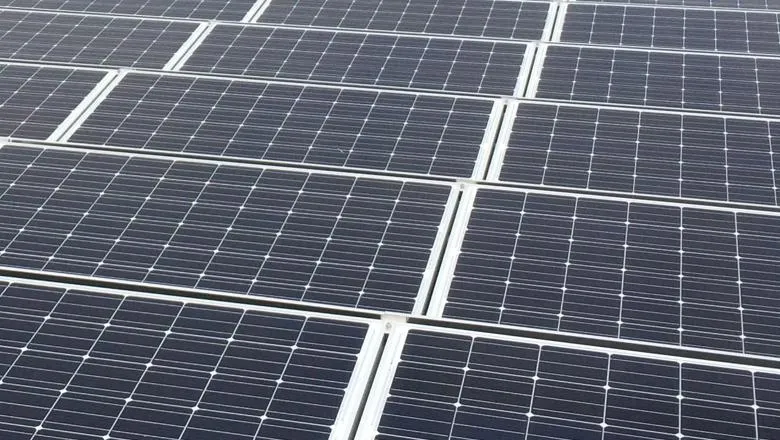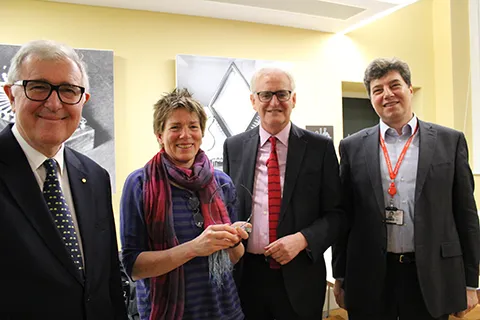15 February 2016
Wheatstone Lecture 2016
New materials for solar to electric energy conversion – Opportunities and challenges

Professor Jenny Nelson of Imperial College London
Professor Peter Main, Head of the Department of Physics at King’s College London, introduced the Wheatstone Lecture this year, describing the storied history of Physics in the university and the work of Wheatstone himself in doing physics that made a difference. With climate change the biggest problem facing the human race, Professor Main said that the idea of physics someday solving this problem was something he was immensely happy about.

Solar power is the fastest growing single technology globally, explained Professor Jenny Nelson from Imperial College London, and it is part of the majority of government plans to achieve future energy targets. There is good reason for this: the sun provides us with a massive amount of energy, 100,000 terawatts, and we humans consume a mere two, and only one percent of that is through conversion to electrical power.
So how do solar cells work? The sun emits photons, which are packets of electromagnetic energy, each with a different energy level, Professor Nelson explained. When these photons encounter matter they energise the electrons present in that matter, often promoting them to a higher energy level and allowing them to break free. If there is an adjacent material that the electrons can diffuse into, this generates an electromotive force and this process is called the photovoltaic effect.
The first observation of the photovoltaic effect was by Edmund Bequerel when he generated an electrical current by illuminating platinum with different types of light, including sunlight. In 1877, William Adams and Richard Day at King’s College London looked at platinum contacts that generated a current when exposed to light and ask whether it was possible to produce an electromotive force with light in selenium. Then, in 1883, Charles Fritts demonstrated a deliberate photovoltaic effect in selenium.
Solar cell manufacture has since moved away from using two different types of materials to generate an electromotive force, to using semiconductors, which have asymmetry built in. These are often composed of silicon that has been modified, or “doped”, so that one side has more electrons than holes and the other has more holes than electrons, allowing electrons to move in a given direction. When solar cells composed of these semiconductors are arranged in series, they can produce enough voltage that the excess can be used or stored.
Looking at the most efficient solar cells the maximum efficiency achieved is about 40% and most materials achieve no more than 20%. This is because some light is too low in energy so does not sufficiently energise the electrons (transmission), because some is too high in energy and produces heat (thermalisation), or because defects in the material stop electrons from moving freely and cause them to recombine with the original structure.
Efforts have been made to increase the fraction of the solar spectrum that can be absorbed by the material in a solar cell to minimise losses by transmission and thermalisation and this is getting close to becoming a real solution to increasing efficiency. Adding another layer that can absorb low wavelengths of light and reemit them is also possible but this technology is still in its infancy.
The most common material currently used in solar cells is crystalline silicon, which is at about 20% efficiency. Despite this relatively good efficiency the uptake by the public is still very low and this is largely because the cost remains prohibitively high. Professor Nelson suggested that replacing the semiconductor material with something cheaper was a good first step to increasing uptake. In terms of lower cost, printable photovoltaics with semiconducting inks are the ideal candidates for mass producible, cheap solar cells.
Other approaches have suggested using organic polymers or nanoparticles in semiconductor design and this area has recently attracted a lot of attention. For organic molecules, to persuade the electron to separate, you need to mix in something else with a stronger affinity for electrons. This mixture is called a heterojunction. As these molecules are mixed in solution it means that they can be held between flexible substrates and also suggest that they can be printed.
To make these organic cells even better the focus is now on understanding how much energy is being lost and at what stage: absorption or recombination. Given that absorption of photons is related to their emission in a measurable way, running a device as an LED allows you to generate data that shows where energy is being lost. From doing this, researchers have concluded that recombination losses are similar across solar cells and absorption varies between materials. This means that selecting materials carefully will allow the use of molecules with less disorder, reducing energy loss due to absorption.
Professor Nelson concluded the 2016 Wheatstone Lecture with her opinions on the outlook for solar power. In summary she said that solar power is abundant, sustainable, versatile and available but we need cheaper materials and technology to increase uptake and make it available to everyone. Nano- and molecular materials offer the potential for this radically cheaper technology but there are challenges remaining at a basic level in terms of integrating this technology into the current energy system. Finally she said, echoing Professor Main’s thoughts from the start of the lecture, that this was a challenge for all of the young scientists in the room, to use physics to make changes to the world.
